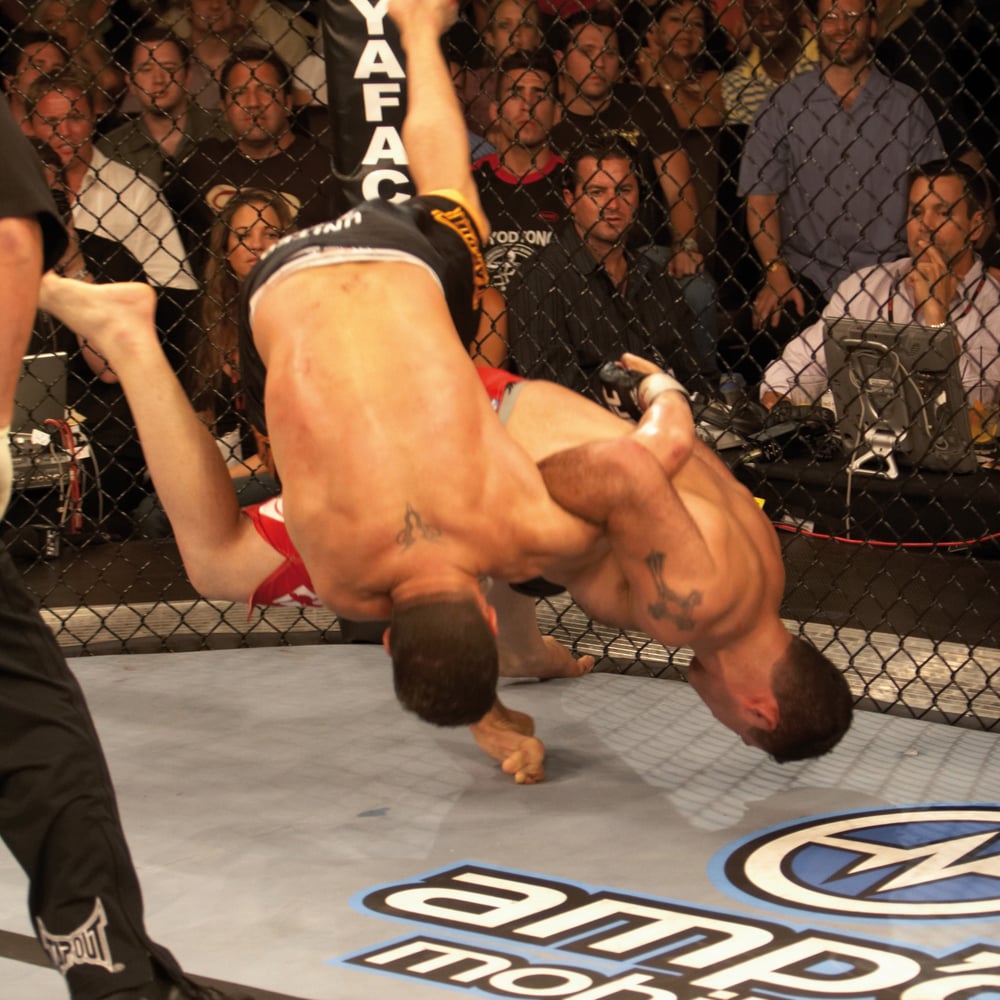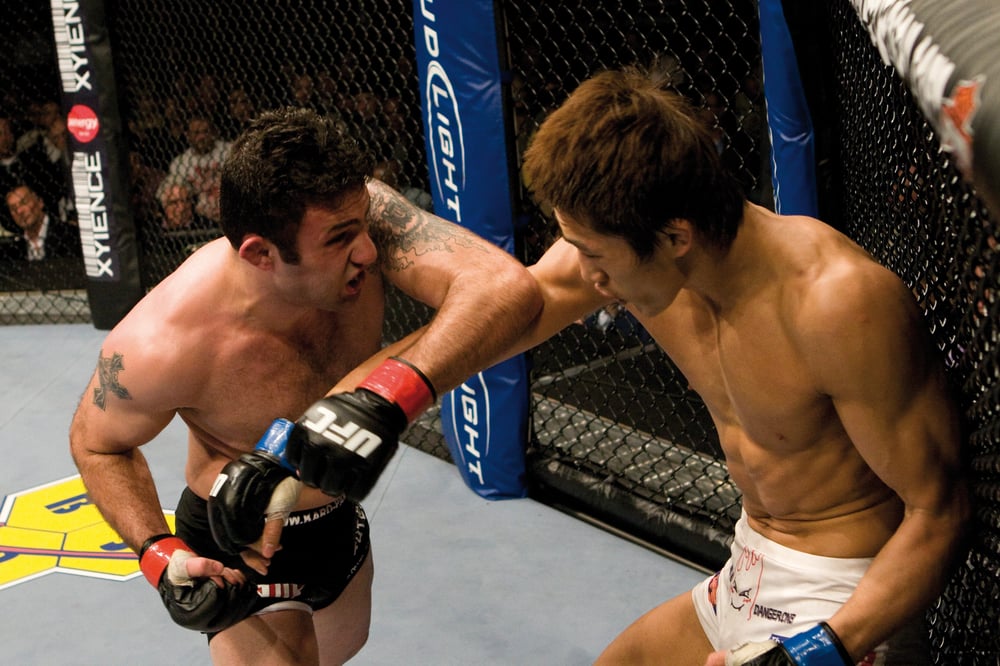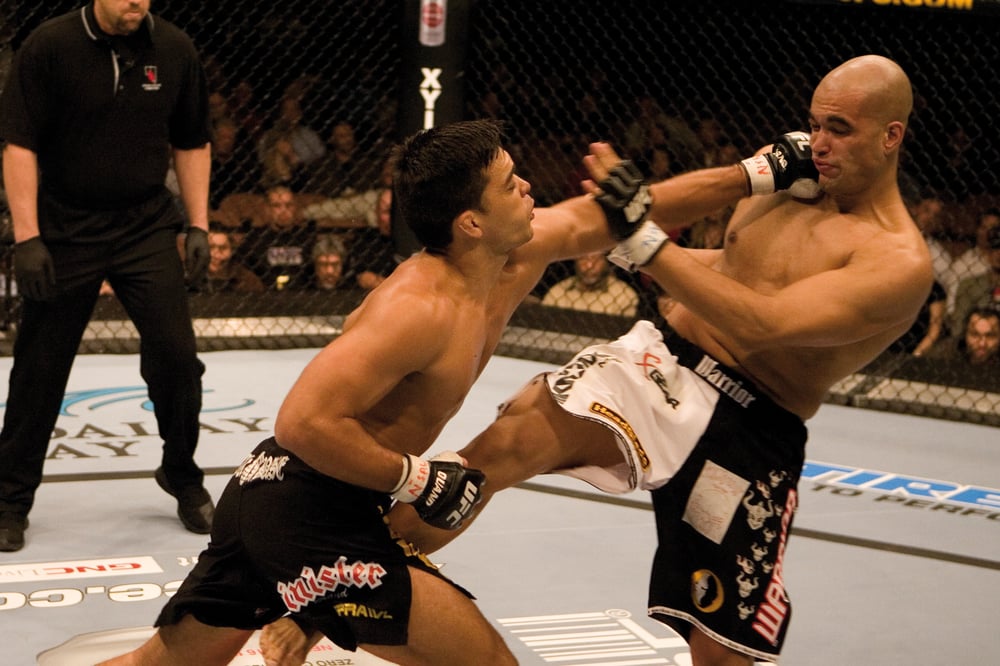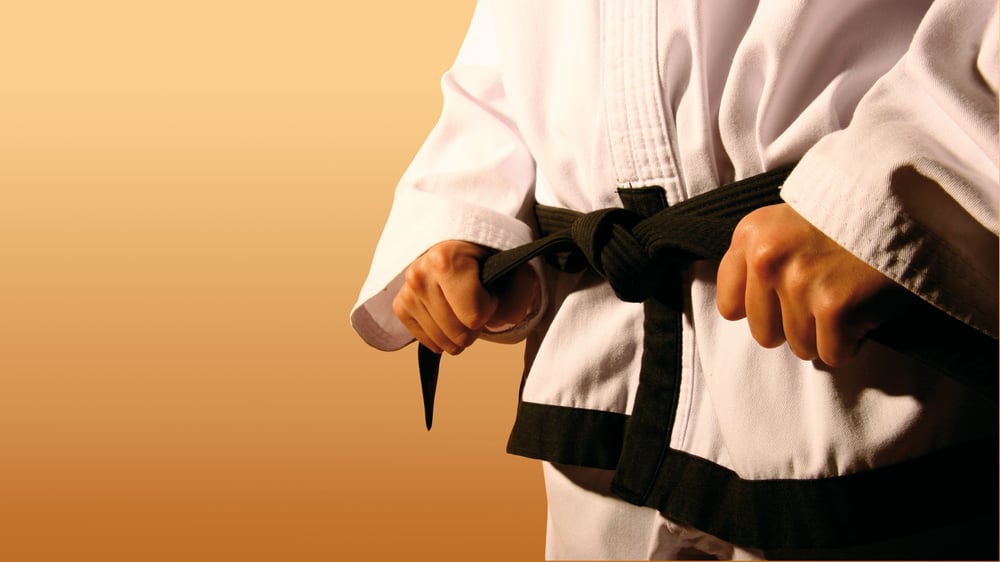
Issue 048
April 2009
After outgrowing the old names of ‘vale tudo’, ‘no holds barred’, and good old ‘cage fighting’, our sport has become known as mixed martial arts (MMA). This handle evokes images of serene exponents of the traditional martial arts, yet some of the marketing still panders to the lowest common denominator, highlighting the chance of blood and guts. This begs the question, is there really any artistry in two guys kicking the shit out of each other for people’s amusement? Where is the ‘art’ in mixed martial arts? Mick Bower finds out.
At 17 years of age, Greg Jackson refined his experiences as a street fighter and shaped them into a fully rounded system of self-defense. Since then, he has built a reputation as one of the top trainers in MMA and is the man behind UFC champs Rashad Evans and Georges St Pierre. The pragmatic Jackson believes that what happens in the cage is far more than mere entertainment.
“I think it [MMA] is a martial art itself, but it’s combined martial arts. The story’s always the same. It should teach you respect. It should teach you how to be humble along with teaching you how to be powerful. That’s still intact. I think what happened is, a lot of the old martial arts moves aren’t relevant to what we do today. I’m not trying to kick somebody off a horse or fight somebody with a samurai sword. I think we should remember that. While the techniques change, the spirit remains the same.”

Dave Camarillo coaches stars such as Josh Koscheck, John Fitch, and Paul Buentello at the American Kickboxing Academy [AKA]. A black belt in both judo and Brazilian jiu-jitsu [BJJ], he fused the two arts to create a ground-breaking system of grappling: Guerrilla jiu-jitsu. Camarillo’s unique background informs his view.
“I will never see MMA as a martial art for many reasons. It is by definition a collection of other arts, and in that you see the recipe for success. Many mixed martial artists misunderstand the idea behind MMA, which is that all aspects of fighting should be developed separately, then put together. Most fighters, even in the UFC, will never grasp this concept, thus will only go so far.
“I remember traditional striking martial arts coming under attack during the rise of Brazilian jiu-jitsu and MMA competitions. They were called ‘ineffective’ from the fighting point of view, but that extreme view comes with great ignorance.
“You need to be a fan of all the arts to truly learn them. Jon Fitch learned movement by watching boxing on TV while he was bartending. I tell my students all the time, they should know who I am talking about when I mention jiu-jitsu competitors like Marcelo Garcia and Roger Gracie, and grappling instructors like John Danaher and Shawn Williams.
“If a fighter is not a fan of other arts they overlook the importance of that art. I would have to say that, even at a high level, I don’t see enough of that. I see a lot of the ‘right’ mentality in my friend Kenny Florian. He is a true martial artist.”
Even a no-nonsense operator like Greg Jackson acknowledges that there is still a place for the traditional arts.
“I think there should be fencing schools everywhere because the underlying structures in combat are ubiquitous. They work for fencing, they work for basketball. The stuff that works in karate works in everything. Nobody carries rapiers around anymore, but it’s really cool to learn. It can still teach you about combat, but if you’re actually looking to defend yourself in this day and age, it’s probably not the best thing for you. But that doesn’t invalidate it.”

Matt Hume is an icon of MMA. When his fighting career ended he became a key figure in the Pride organization. His AMC Pankration gym has attracted fighters such as Hayato Sakurai, Rich Franklin, and Josh Barnett. He has been involved in the combative arts since the age of four and believes that being a martial artist requires complete dedication.
“My philosophy is to try to achieve perfection as a martial artist: pushing yourself to master current technique, conditioning, and mental focus, and then go beyond what others have achieved in those areas. In order to do that it requires a lifetime of commitment and dedication, not preparation for a fight.
“The artistry is in the individual. There are some MMA practitioners that live and train as martial artists. Unfortunately, the majority of MMA competitors simply want to fight, and, in the end, fail due to their short-sightedness and lack of qualities that pertain to martial artists, as opposed to fighters.”
This argument suggests that fighting professionally is actually detrimental to the progression of an artist. Look at professional boxing and you’ll see that skill and integrity are valued less than slugging and trash-talking. The lure of fame and fortune inevitably influences the outlook of participants. But any form of regulated competitive fighting could be viewed as compromising the truth of an art. Dave Camarillo notes that this phenomenon occurs across the board.
“I never influence my students to compete. If they want to I will support them. I am not in this business to create great jiu-jitsu champions. I teach my students to become great grapplers. I train them from the stand-up to the ground. I teach wrestling, judo, and jiu-jitsu. I specifically do not train them for competition because I have seen many BJJ world champions that I don’t consider great grapplers. The rules of BJJ water down the realization of a fight. I want my students to be able to protect themselves, not win some match where lying in your half-guard is a good strategy.
“I live by the idea that we should question everything. My game is probably less than 10% of what I was taught by Ralph Gracie. I have changed things, added things, and have been exposed to champions like BJ Penn and Marcelo Garcia. A good student has an open mind to everything.”

The case can be made that MMA, with its minimal rules, is the closest thing to a ‘real’ fight it is possible to have. With fewer boundaries, artists have more room to express themselves. Inspired by what they see on the canvas, new blood is flooding into the martial arts. The early UFCs revolutionized thinking about how we fight, and the evolutionary progress continues.
Although technique is important, martial arts has always been about more. The ancient arts demand that as much attention is paid to the inner self as the physical self. Anyone participating in MMA needs to possess the psychological tools that enable them to perform in high-pressure situations. Greg Jackson believes a full-contact lifestyle is the key to mental improvement.
“Bruce Lee said, ‘If you want to learn to swim, you’ve got to get in the water’. Just throwing punches in a mirror is not going to teach you anything about fighting. That always made me laugh about that Matrix movie. There’s one point where he’s like, ‘Now I know kung fu’, and he’s this amazing fighter. The technical stuff has so little to do with it.
“There’s that old Celtic proverb, ‘see much, study much, suffer much’, as the path to learning and I really think the martial arts give you those three things. They give you so many opportunities to suffer. To see things you wouldn’t ordinarily get to see, to experience things like hardship that you wouldn’t ordinarily get to experience. I think that gives you a lot of wisdom. If you do that throughout your life, you’re constantly trying to better yourself as a person and better yourself as a martial artist.
“A lot of fighting is experience. You have to be able to fall back on that experience and hard sparring sessions give you that experience, so that it’s not something new and scary and it’s kind of old hat. When something is old hat, so to speak, it goes to plan.
That new Batman movie had a great speech by the Joker about how, ‘As long as everything goes to plan, people don’t panic’. I think that’s very true, especially in fighting. As long as you know you’re going to suffer and stuff is going to suck and you’ve just got to keep doing it, you’re going to be all right. If it’s outside of the plan, you’re going to start freaking out. So your job with a fighter is to make it a normal, everyday part of the plan, the suffering, and the fighting.
“If you’re this beautiful flowing guy with these gorgeous techniques but you have no will to win, as soon as the fight gets hard, you’re going to stop. You want to have the will to win, absolutely, but you also have to want to follow the way. You want to do things the right way. Not just coming out wild and landing a big punch and celebrating like it’s the end of the world, but coming out, setting things up, doing it correctly. Following the art is very important. I like the will to win coupled with doing it correctly. With style, if you will.”

Dave Camarillo states that a grounding in a traditional art should be the first step on the road to excellence. “I believe that, on a technical level, we see a great value in traditional arts for our children. When building an MMA fighter from birth to adulthood there are many aspects of development that are generally ignored. The fighters I have at AKA that are the most respectful are also the most successful. Having a respectful fighter means you have a student that understands how to work smart. Respect is a more conducive attitude for learning. So when we put a child through a traditional martial arts program like karate, they learn right away the respect and honor they will need if they engage in an MMA career. I would also say that, technically, they will learn great coordination needed to make the transition to other arts that are necessary aspects of the fight game.
“I think judo is the greatest martial art for any child who aspires to be an MMA fighter. Judo should be learned within the rules that govern the sport first. Then one should train their throwing skills in the context of an MMA clinch, mixed with striking and wrestling. It teaches you respect, good hip movement, great throws, and decent groundwork. It also builds your core like no other art. All of this is necessary for learning all aspects of fighting.”
Camarillo offers Karo Parisyan as the best example of a judoka who has adapted his game to MMA. Others have shown that it is possible to achieve success by bringing old-school skills into the cage. Lyoto ‘The Dragon’ Machida has risen to the heights of the UFC’s light heavyweight division with a style that betrays his background in karate. Famously elusive, he frustrates his opponents by flitting in and out of range and regularly changing his stance. Anyone who catches up with Machida feels the sting of his impressive roundhouse kicks and sharp, straight punches.
Also unbeaten (but far more spectacular) is Cung Le. On his march to the Strikeforce middleweight title the San Shou specialist threw side and spinning back-kicks that have rarely been seen outside of a Jet Li movie. Watch Cung Le and rumors that the truth killed kung fu suddenly seem wildly exaggerated.
Le and Machida are the latest in a long line of people who have dropped something new into the melting pot of MMA. Matt Hume explains. “Bruce Lee was not a fighter, but his fighting concepts were ahead of his time and still very valuable to the modern MMA fighter. The same is true with the Gracie family and what they have brought to martial arts and MMA. There are many who have strived to bring reality to old-school martial arts, and those who currently push the envelope of technique in modern MMA, such as Fedor, Penn, GSP, and Silva.”

To find the art in MMA you must return to the source. The originators of the traditional martial arts were seeking to find the ultimate system for winning fights in their reality. They drew upon their experience and observations, which could involve military action, or just watching the toughest five animals they knew.
Becoming a martial artist is a personal commitment. You must make improving yourself your main priority, and place it above any desire for acclaim and rewards. Times change and so must the martial arts. What we now think of as the traditional Japanese arts are relatively recent remixes of ancient classics. Modern MMA offers an arena to carry on the work of the old masters, a place to test ideas and push the knowledge of fighting to the next level.
Not every fighter is a martial artist in the same way that not everyone who paints a picture or cuts a cow in half is an artist. The traditional arts have been discredited by frauds and people are so caught up in their sectarian quarrels they have lost sight of what they are trying to accomplish. Similarly, a proportion of MMA fighters (even at the top level) display no evidence of artistry, spewing out disrespect and swinging for the fences as they hope to hype their way to the promised land of title shots and Cristal.
For true martial artists of all disciplines, MMA has changed the landscape forever. As cross-training becomes the norm and fighters are exposed to new methods the ongoing destructive testing can only have a constructive outcome. Surely, by breaking down barriers, MMA is the natural extension of the work started by the pioneers of martial arts.
Greg Jackson sums up why we should all be optimistic about the future. “Bruce Lee was such a genius. He had the right idea with jeet kune do. It really is mixed martial arts. It’s taking what works and what doesn’t and, more than that, now myself and lots of others are innovating. We’re coming up with new moves and new ways to do things, or rediscovering, because I’m sure other people discovered these things in the past. This is the most exciting time to be alive in the martial arts, because we have the entire world at our fingertips – I can fly to Thailand and train Muay Thai. Even more important, I have videotapes where I can watch fights or people can talk about what they do. It’s not a book. It’s not a series of pictures. You can actually watch a fight where moves are working or not working.
“This has never happened in humanity before. We’re seeing all the best of these ancient cultures and then pushing forward and figuring out new ways to do stuff. It’s a really exciting time to be alive.”
...









